早二叠世塔里木大火成岩省由大陆溢流玄武岩及其相关的镁铁—超镁铁—长英质层状侵入体和基性岩墙群组成(杨树锋等,1996;Zhang et al.,2008,Zhang 2010;Zhou et al.,2009;陈咪咪等,2010;Tian et al.,2010;Wei et al.,2014)。塔里木东北缘北山地区位于中天山地块的南侧,因其出露大量的镁铁—超镁铁岩体并具有产出一系列铜镍矿床的潜力而成为近年来地质学界关注的焦点(姜常义等,2006;Mao et al.,2008;苏本勋等,2009,2010,2011;Qin et al.,2011;Su et al.,2011;Xia et al.,2013)。这些镁铁—超镁铁岩锆石U-Pb年龄介于289~274 Ma之间,与新疆东部镁铁—超镁铁质成矿岩体时代相似,均为早二叠世(韩宝福等,2004;姜常义等,2006;肖庆华等,2010;Qin et al.,2011;Su et al.,2011;Tang et al.,2011)。坡十超镁铁质侵入体是坡北岩带中规模较大、最具代表性的岩体之一,近年来大量的勘探工作使得坡十找矿工作取得重大突破。前人对该侵入体的年代学及成岩成矿过程等方面开展了初步的研究工作,取得以下主要进展:1)坡十含矿侵入体的直接围岩辉长岩形成于276 Ma左右(姜常义等,2006;李华芹等,2009;Ao et al.,2010;Qin et al.,2011);2)相对于东天山同时代镁铁—超镁铁岩体,坡十侵入体可能来自于更为原始的母岩浆和更加动态的岩浆系统(Yang et al.,2014);3)坡十超镁铁岩的形成主要受结晶分异作用控制,亦有明显的壳源混染,硫化物熔离发生在岩浆演化的早期,壳源混染可能是硫化物熔离的主要机制(苏本勋等,2011;Yang et al.,2014)。然而目前为止,对于坡十超镁铁侵入体的矿物学研究,特别是主要造岩矿物成因意义的研究比较薄弱。
橄榄石作为含矿的超镁铁岩中最主要的造岩矿物,其Fo值和Ni含量蕴含丰富的成岩成矿信息。同时橄榄石的成分也能反映原始岩浆性质,对持续的岩浆补给、壳源物质的加入、硅酸盐熔浆的分离结晶和硫化物熔离作用起到良好的指示作用(Li et al.,2007;李士彬等,2008;陈列锰等;2009;邓宇峰等,2012)。铬尖晶石通常是镁铁—超镁铁岩体中最早的结晶相之一,对岩石成因和动力学过程有重要的指示作用(Irvine,1967;Dick and Bullen,1984;Liipo et al.,1995;Barnes and Roeder,2001)。铬尖晶石也被用来指示超镁铁岩赋矿的岩浆硫化物矿床的成因(Zhou et al.,1997;Barnes and Tang,1999;Barnes and Kunilov,2000)。本文通过对坡十超镁铁侵入体中橄榄石和铬尖晶石矿物化学成分的研究,模拟计算坡十侵入体母岩浆成分,讨论其形成过程中岩浆结晶分异及硫化物熔离过程之间的内在联系,论证坡十侵入体的源区特征,以期为北山镁铁—超镁铁岩体的找矿和勘查工作提供科学依据。
1 地质背景和岩体特征新疆北山地区位于塔里木板块东北部,中亚造山带南缘(图 1a)。区内出露的古老结晶基底为古元古代北山群、中元古代长城系白湖群和杨吉布拉克群、蓟县系爱尔基干群(肖渊甫等,2000);石炭纪火山活动形成海相火山岩—复理石—碳酸盐岩建造;二叠纪火山活动强烈,以基性火山岩为主,并形成了许多中酸性和镁铁—超镁铁岩体。区内由于受长期构造运动的影响,褶皱和断裂等构造较发育,区域构造线方向呈北东向,构造格局由南到北受红十井—矛头山大断裂、白地洼—淤泥河大断裂、红柳河—依格孜塔格大断裂的联合控制。其中白地洼大断裂是一条具有长期活动特点的超壳断裂,它既是控岩构造又是控矿构造,控制着坡北镁铁—超镁铁岩带的分布,也控制着坡北华力西晚期铜镍成矿带的分布。到华力西晚期形成北北东向线状褶皱,北北东向断裂再次活动,局部形成北西向走滑断层。
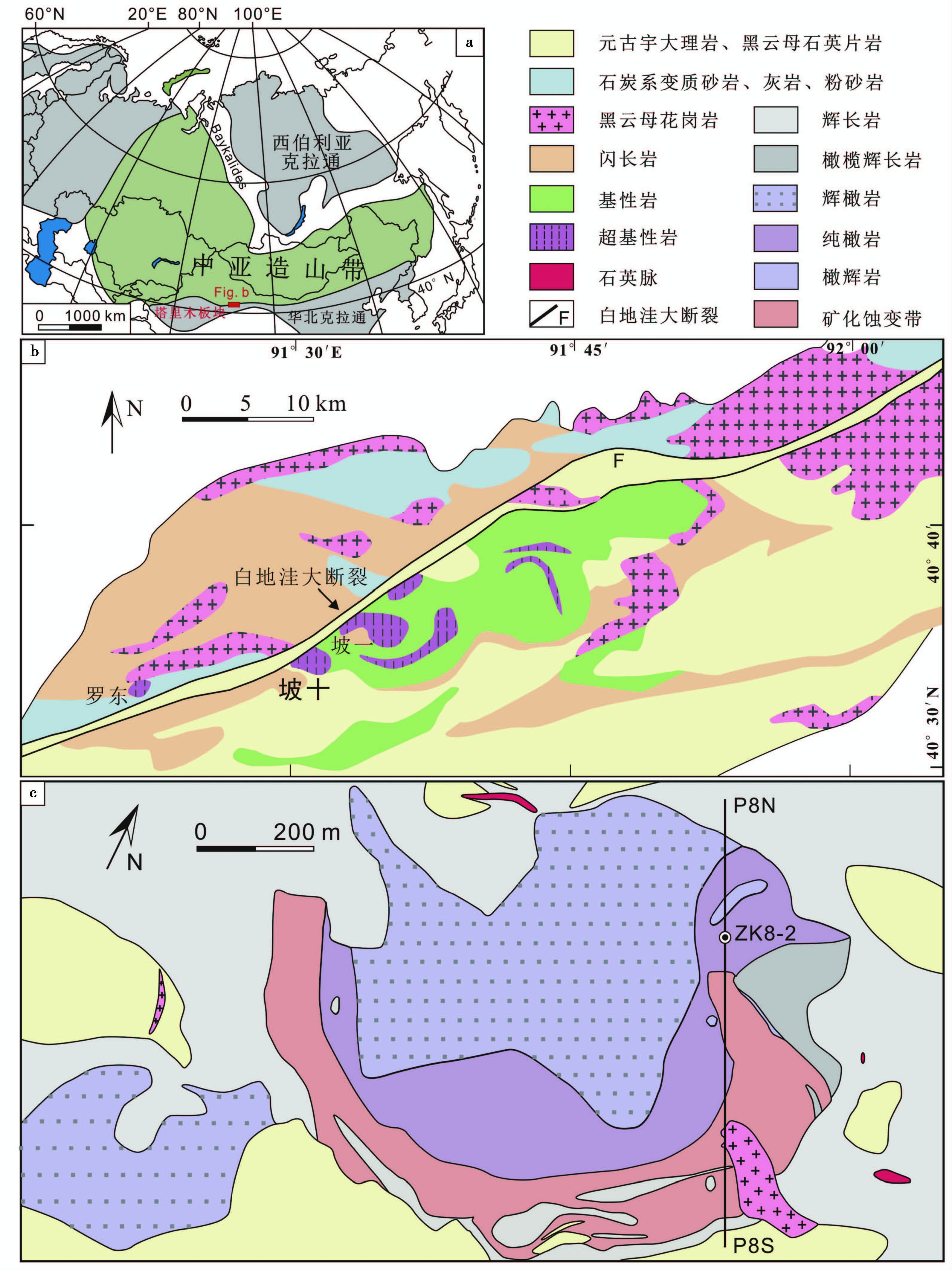
|
图1 塔里木板块和中亚造山带地质简图(a;据Li et al.,2012修改),新疆北山坡北镁铁—超镁铁岩体位置图(b;据苏本勋等,2011修改) 和坡十镁铁—超镁铁侵入体及其围岩的地质简图(c;据Xue et al.,2016 修改) Fig.1 Tectonic units and location of Tarim block and central Asian orogenic belt(CAOB)(a;modified after Li et al.,2012),sketch map showing distribution of Pobei mafic-ultramafic intrusions in Beishan,Xinjiang(b;modified from Su et al.,2011)and sketch map of the Poshi mafic-ultramafic intrusion(c;modified from Xue et al.,2016) |
坡十超镁铁侵入体位于北山西段的白地洼断裂南侧(图 1b),为坡北镁铁—超镁铁岩体数个超镁铁岩侵入中心之一。坡北岩体为两次岩浆侵位形成:第一侵入期次形成外围大面积的橄榄辉长苏长岩、橄榄辉长岩和辉长岩;第二侵入期次形成坡十等超镁铁侵入中心,其中,第一阶段形成(斜长)单辉橄榄岩、(斜长)二辉橄榄岩和纯橄岩,第二阶段产出橄榄单辉岩。坡十超镁铁侵入体呈直径约为1.8 km的不规则圆状产出,出露面积约为2.5 km2,多被第四系覆盖,其中剖面上超镁铁岩相南、北边界均向北倾。其中(斜长)单辉橄榄岩和(斜长)二辉橄榄岩是坡十超镁铁侵入体的主要岩相,也是含矿岩相,两者呈渐变过渡关系分布于侵入体中心及西北侧,地貌上多处于负地形地带;纯橄岩伴随辉橄岩或独立出现,主要分布在超镁铁侵入体的南部和东部,纯橄岩中可见辉长岩捕虏体;橄榄单辉岩零星分布于坡十侵入体东侧(图 1c)。坡十超镁铁侵入体的直接围岩为坡北的辉长岩体,外围出露元古宇黑云母片岩、二云母片岩、石英岩黑云母二长变粒岩等和少量的下石炭统粗粒大理岩。该侵入体外围辉长岩锆石TIMS U-Pb 测年结果为274±4 Ma(姜常义等,2006),橄榄辉长岩中的锆石LA-ICP-MS U-Pb定年结果为275.5±1.2 Ma(Ao et al.,2010),辉长岩锆石SIMS U-Pb 定年结果为284.0±2.2 Ma(Qin et al.,2011)。坡十侵入体的矿石类型以星点状—稀疏浸染状为主,金属硫化物矿物以磁黄铁矿、镍黄铁矿最为常见,其次为黄铜矿,矿石镍品位一般为0.2%~0.6%,局部品位较高,达0.96%,具有镍、钴紧密伴生及铜品位较低的特征。
2 岩相学和矿物学特征纯橄岩具正堆晶结构,其组成矿物除橄榄石外,还含有少量单斜辉石、尖晶石和金云母等。橄榄石一般呈自形或浑圆状,粒径多集中在0.5~5 mm之间,通常呈堆晶相或粒状镶嵌状被硫化物包裹(图 2a),裂纹发育,沿裂纹多见蛇纹石化。纯橄岩中橄榄石颗粒存在波状消光现象,且橄榄石中常见尖晶石包裹体和少量硫化物包裹体。蚀变纯橄岩中蛇纹石化发育,近地表岩石也可见伊丁石化。
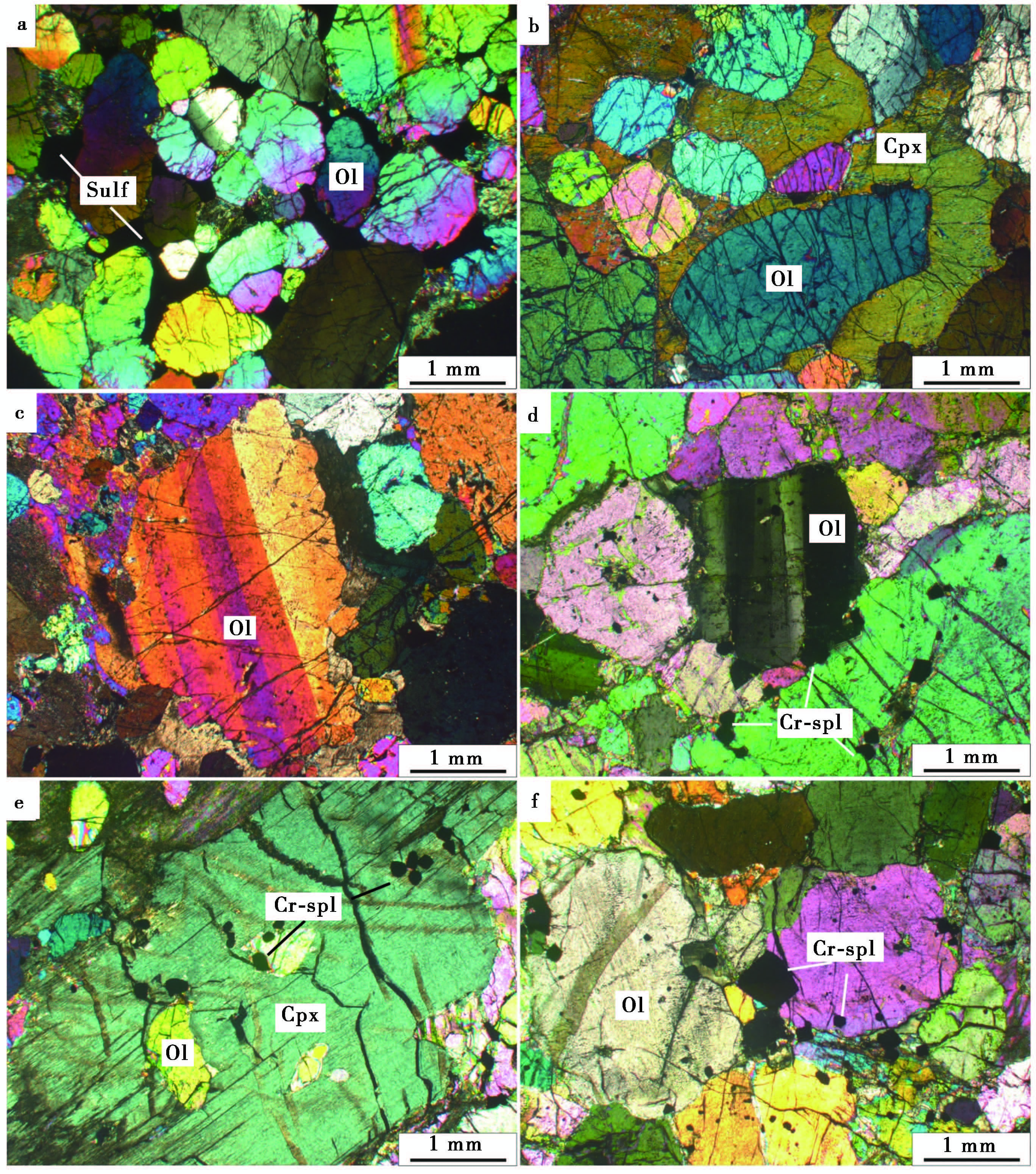
|
图2 坡十侵入体橄榄岩的显微照片 a.纯橄岩,橄榄石呈粒状被填隙相硫化物包裹;b.单辉橄榄岩,包橄结构,单斜辉石呈他形包裹新鲜橄榄石颗粒;c.橄榄石波状消光;d.橄榄石波状消光,尖晶石分布在橄榄石颗粒之间或被橄榄石包裹;e.二辉橄榄岩,包橄结构,自形辉石包裹半自形橄榄石和尖晶石,同时可见橄榄石包裹尖晶石;f.大颗粒自形尖晶石产出在橄榄石颗粒之间,小颗粒半自形尖晶石被橄榄石包裹。Ol.橄榄石;Cpx.单斜辉石;Cr-spl.尖晶石;Sulf.硫化物 Fig.2 Microphotographs of peridotites from Poshi intrusion |
(斜长)单辉橄榄岩和二辉橄榄岩呈黑褐色—黑色,中细粒结构,块状构造;橄榄石含量为45%~90%,呈各式熔蚀浑圆粒状—自形粒状,粒径为0.5~6 mm,部分裂纹发育,沿裂纹有网状纤维蛇纹石化蚀变(图 2b、图 2d、图 2e),同时部分橄榄石颗粒存在波状消光现象(图 2c、图 2d);辉石含量为10%~55%,自形短柱状—他形,粒径为0.2~4 mm,呈他形的辉石以包裹橄榄石和尖晶石常见(图 2b、图 2e);部分样品含少量斜长石(约占5%),呈他形—半自形板状、粒状产于橄榄石粒间,粒径为0.3~4 mm;坡十超镁铁侵入体中铬尖晶石的产状分为3种:1)被橄榄石包裹,粒度相对较小且多为半自形颗粒(图 2d、图 2f);2)被辉石和金云母包裹,自形—半自形颗粒(图 2e);3)呈填隙相产出于硅酸盐颗粒之间,粒度较大,自形—半自形—他形颗粒均可见,并有少量晶体包裹橄榄石和辉石,表现为晚期结晶的特征。岩石蚀变较常见,主要是蛇纹石化,具普遍的褐铁矿化,局部见有孔雀石化。从钻孔ZK8-2剖面上可以看出,蚀变程度由上部层位的强蚀变岩石逐渐过渡到中下部的新鲜岩石(图 5)。
3 样品分析方法样品采自坡十侵入体8号勘探线(P8N-P8S)上的钻孔ZK8-2(图 1c),对不同矿化程度的纯橄岩、单辉橄榄岩、(斜长)二辉橄榄岩样品进行光薄片磨制。本次研究选择不同产状且蚀变程度低的橄榄石颗粒和不同产状的铬尖晶石进行分析测试。橄榄石和铬尖晶石主量元素分析在中国科学院地质与地球物理研究所岩石圈演化国家重点实验室完成,分析仪器为日本JEOL公司生产的JXA 8100电子探针,其工作电压为15 kV,电流20 nA,束斑大小为3 μm。橄榄石和铬尖晶石的电子探针分析结果列于 表 1和表 2。
|
|
表 1 坡十超镁铁侵入体橄榄石氧化物成分/%及Ni含量/×10-6 Table 1 Oxide/% and Ni/×10-6 contents in olivine from Poshi ultramafic rocks |
|
|
表 2 坡十超镁铁侵入体尖晶石氧化物成分/% Table 2 Oxide contents/% in Cr-spinel from Poshi ultramafic rocks |
坡十超镁铁岩的橄榄石数据来自本次研究和苏本勋等(2012),总体上成分变化范围较大。 其中纯橄岩中的橄榄石Fo值范围在83.2~88.8之间,Ni含量多集中在526×10-6~3 795×10-6 之间;单辉橄榄岩的橄榄石Fo值为78.1~89.6,Ni含量在1 503×10-6~4 580×10-6 之间;二辉橄榄岩的橄榄石Fo值为83.4~88.6,Ni含量多集中在767×10-6~1 933×10-6 之间;斜长二辉橄榄岩中的橄榄石Fo值主要集中在76.8~81.0之间,Ni含量多为1 132×10-6~1 812×10-6。
坡十超镁铁侵入体中铬尖晶石的Mg#值和Cr#值变化范围分别为19.4~41.9和49.8~64.8。其中橄榄石为主晶的尖晶石变化范围最大,主要氧化物成分为18.4%~23.1%Al2O3、24.2%~34.0%FeOt、4.6%~8.4%MgO和34.9%~43.9%Cr2O3;辉石和金云母为主晶的尖晶石变化范围其次,这与观察到的辉石和金云母稍晚于橄榄石结晶相符,尖晶石主要氧化物成分为16.8%~25.4%Al2O3、23.1%~31.3%FeOt、4.9%~9.7%MgO和36.6%~46.2%Cr2O3;填隙在硅酸盐颗粒之间的尖晶石变化范围最小,是岩浆演化过程中残余熔体结晶的产物,主要氧化物成分为19.3%~23.1% Al2O3、24.1%~34.6% FeOt、5.0%~8.5% MgO和37.0%~43.9% Cr2O3;3种产状的尖晶石中NiO含量变化范围均较小且都小于0.11%。3种产状的铬尖晶石中FeOt和MgO、Cr2O3和FeOt显示明显的负相关(图 3a、图 3c)、MgO和Cr2O3具有较好的正相关(图 3b),而Al2O3和Cr2O3则表现出正相关和负相关两种趋势(图 3d)。在Fe3+-Cr-Al三角图解中,坡十侵入体的铬尖晶石的Fe3+ 显示出较小的变化(图 7a),并且与区域上同时代的东天山黄山东岩体(~274 Ma)表现出相似的成分特征(Mao et al.,2015),但是与中天山时代较早的峡东Alaskan型岩体(约313 Ma)明显不同(孙赫等,2009a;Su et al.,2012)。
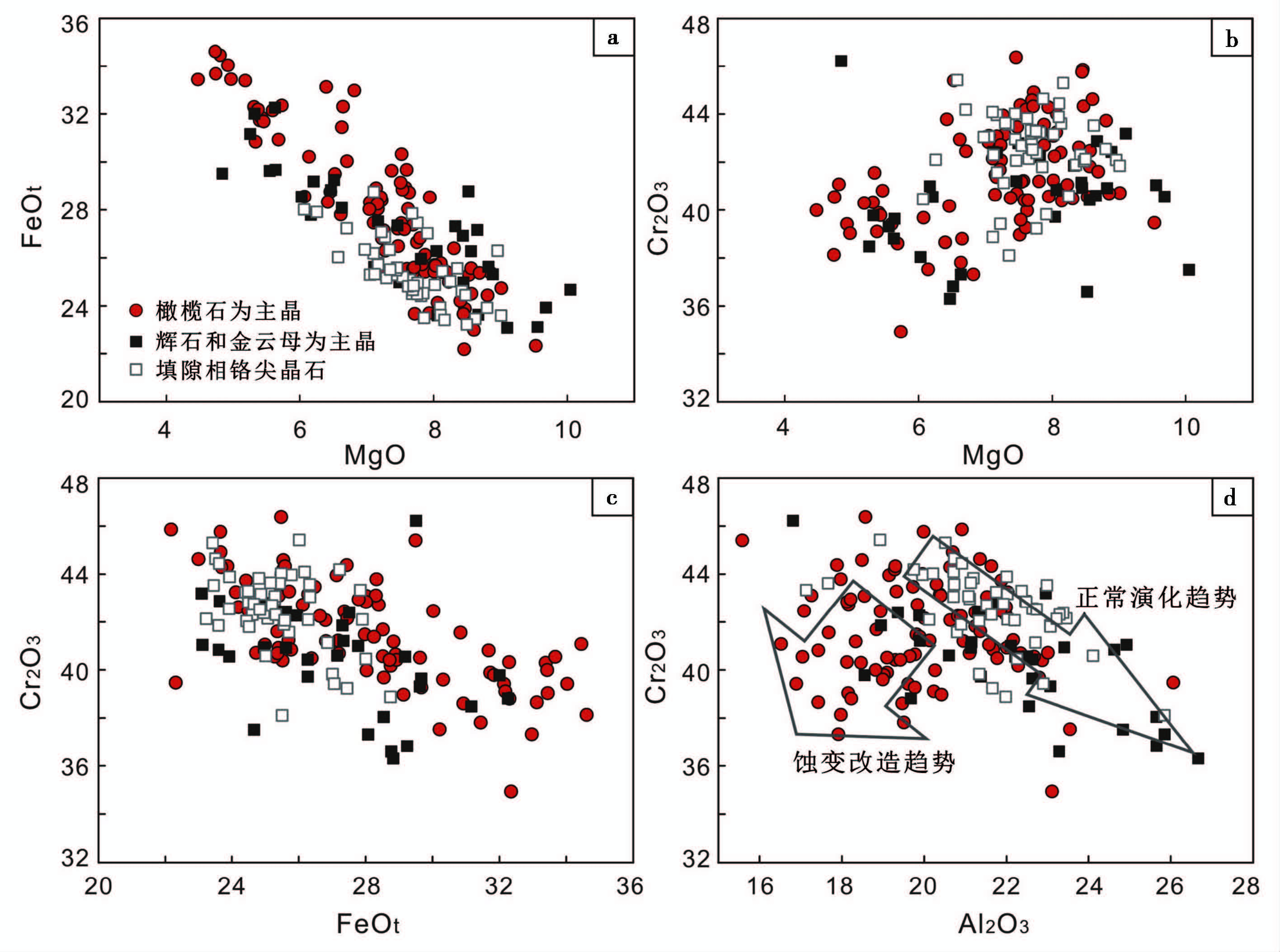
|
图3 坡十侵入体中3种产状的铬尖晶石主量成分相关性图解 Fig.3 Binary variation diagrams of the Cr-spinel composition from Poshi intrusion |
岩浆成因的原生铬尖晶石中Cr2O3和Al2O3通常受分离结晶过程控制,表现为负相关关系(Bliss and Maclean,1975)。而在坡十侵入体铬尖晶石Cr2O3-Al2O3相关性图解中(图 3d),部分铬尖晶石的成分与岩浆成因的铬尖晶石表现出不同的演化趋势。通常在超镁铁岩体蛇纹石化过程中,次生磁铁矿边界与铬尖晶石发生平衡反应,使铬尖晶石成分表现出蚀变改造的趋势(Bliss and Maclean,1975)。坡十侵入体中呈现蚀变改造趋势的铬尖晶石主要是橄榄石为主晶的类别,通常来讲被橄榄石包裹的尖晶石处于一个相对封闭的体系,难以同不断演化的残余熔体发生反应(Roeder and Campbell,1985)。然而在坡十侵入体浅部蛇纹石化较强烈的岩石中,被蚀变得“支离破碎”的橄榄石颗粒边界发育大量的次生磁铁矿,部分橄榄石为主晶的尖晶石颗粒边界也可见次生磁铁矿(图 4)。次生磁铁矿与原生铬尖晶石反应造成铬尖晶石中富Fe(包括Fe3+),同时造成铬尖晶石晶体结构中相同位置的Cr和Al减少,因此坡十超镁铁侵入体蚀变改造的铬尖晶石中,Cr2O3与Al2O3表现出正相关关系(图 3d)。
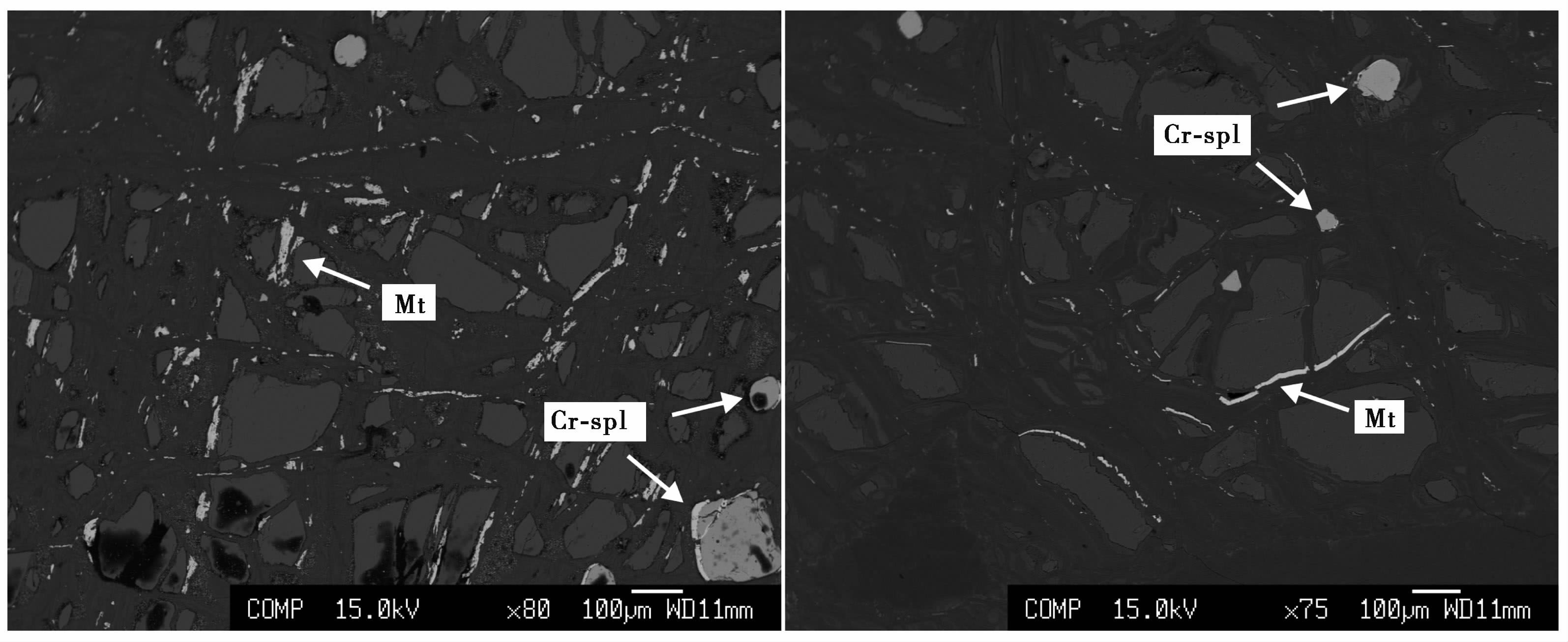
|
图4 坡十超镁铁岩中发育次生磁铁矿细脉的蚀变橄榄石与铬尖晶石背散射图像 Mt.磁铁矿;Cr-spl.铬尖晶石 Fig.4 Back-scattering image of altered olivine and Cr-spinel with thin magnetite rims from the Poshi ultramafic intrusion |
坡十侵入体的铬尖晶石中MgO含量随着 Cr2O3 含量的降低而降低,然而在高MgO含量区域(图 3a、图 3b),早期结晶的铬尖晶石(橄榄石为主晶)并没有表现出比后期结晶的铬尖晶石更高的MgO含量,表明早期结晶的铬尖晶石中MgO含量的降低部分归因于铬尖晶石与橄榄石的Mg-Fe再平衡,反应过程如下:
Mgspinel+Feolivine2+=Mgolivine+Fespinel2+
交换反应中分配系数Kd随温度降低的变化促使Mg进入到橄榄石、Fe进入到铬尖晶石中(Irvine,1965),相似的反应过程也被描述在斜方辉石与铬尖晶石之间(Eales and Reynolds,1986)。
5.2 橄榄石垂向变化与岩浆过程目前全球大部分典型岩浆Ni-Cu-(PGE)硫化物矿床均形成于动态的岩浆通道系统(Li and Naldrett,1999;Naldrett,1999;Li et al.,2001;Lesher and Keays,2002;秦克章等,2012),动态系统中岩浆脉动过程的认识对于硫化物饱和及成矿有重要意义,其中橄榄石成分的垂向变化是识别岩浆过程的有效手段(Li et al.,2003,2004)。前人研究表明影响橄榄石Fo值和Ni含量的主要因素有:1)母岩浆的成分组成;2)岩浆中发生硫化物熔离作用,3)橄榄石和熔离出的硫化物反应;4)橄榄石和后期晶间硅酸盐岩浆反应;5)新鲜岩浆的注入改变了母岩浆中MgO和FeO的比值及Ni 含量(Li and Naldrett,1999;Li et al.,2004;孙赫等,2009b)。
⑤新疆地矿局第六地质大队.2014.若羌县坡十镍矿8号勘探线剖面图(内部资料).
图 5为坡十侵入体东北侧钻孔ZK8-2中岩相组合、矿物比例(橄榄石、辉石、斜长石和尖晶石)、橄榄石Fo值和Ni含量及全岩成分中Ni含量的垂向变化。该钻孔中岩性均为坡北第二侵入期次的超镁铁岩,橄榄石比例大部分高于70%。钻孔中不同岩相之间均呈过渡关系,未见截然界线,钻孔中发育的断裂破碎并不是岩性突变的标志,然而橄榄石Fo值和Ni含量在790 m和200 m处显示出明显的不连续性,表明坡十超镁铁岩侵入体并非由母岩浆在封闭体系下结晶形成。在侵入体下部的1 640~790 m岩性段,橄榄石Fo值基本介于88~90之间(图 5a),Ni含量集中在2 500×10-6 附近(图 5b),全岩中Ni含量集中在0.2%附近(图 5c),三者变化范围均较小。如此厚大的岩性段中矿物和全岩成分如此稳定,那么最可能是成分相近的新鲜岩浆持续向上补给,使得岩浆中Mg#和Ni含量在一定时期内保持在一个相对稳定的区间。在侵入体中部的790~420 m岩性段,橄榄石Fo值和Ni含量同时表现出向上的升高(图 5a、图 5b)。通常在重力分异作用下,早期结晶的橄榄石会向下堆晶,造成橄榄石Fo值和Ni含量表现出向上降低的趋势,这与钻孔中橄榄石的数据结果相反,说明坡十母岩浆在侵位过程中处于动态系统中,持续的补给和多次的脉动给予母岩浆中早期结晶的矿物向上的动力,从而造成了橄榄石Fo值和Ni含量表现出向上的升高;该岩性段中全岩的Ni含量变化范围较大,且局部Ni含量大于0.4%(图 5c),说明硫化物熔离作用的存在,这与该层位矿化特征一致。ZK8-2上部(420~0 m岩性段)橄榄石Fo值和Ni含量均较小,相对浅部的侵入位置使得岩浆温度快速降低,分离结晶速度较快,造成橄榄石成分分异不明显。
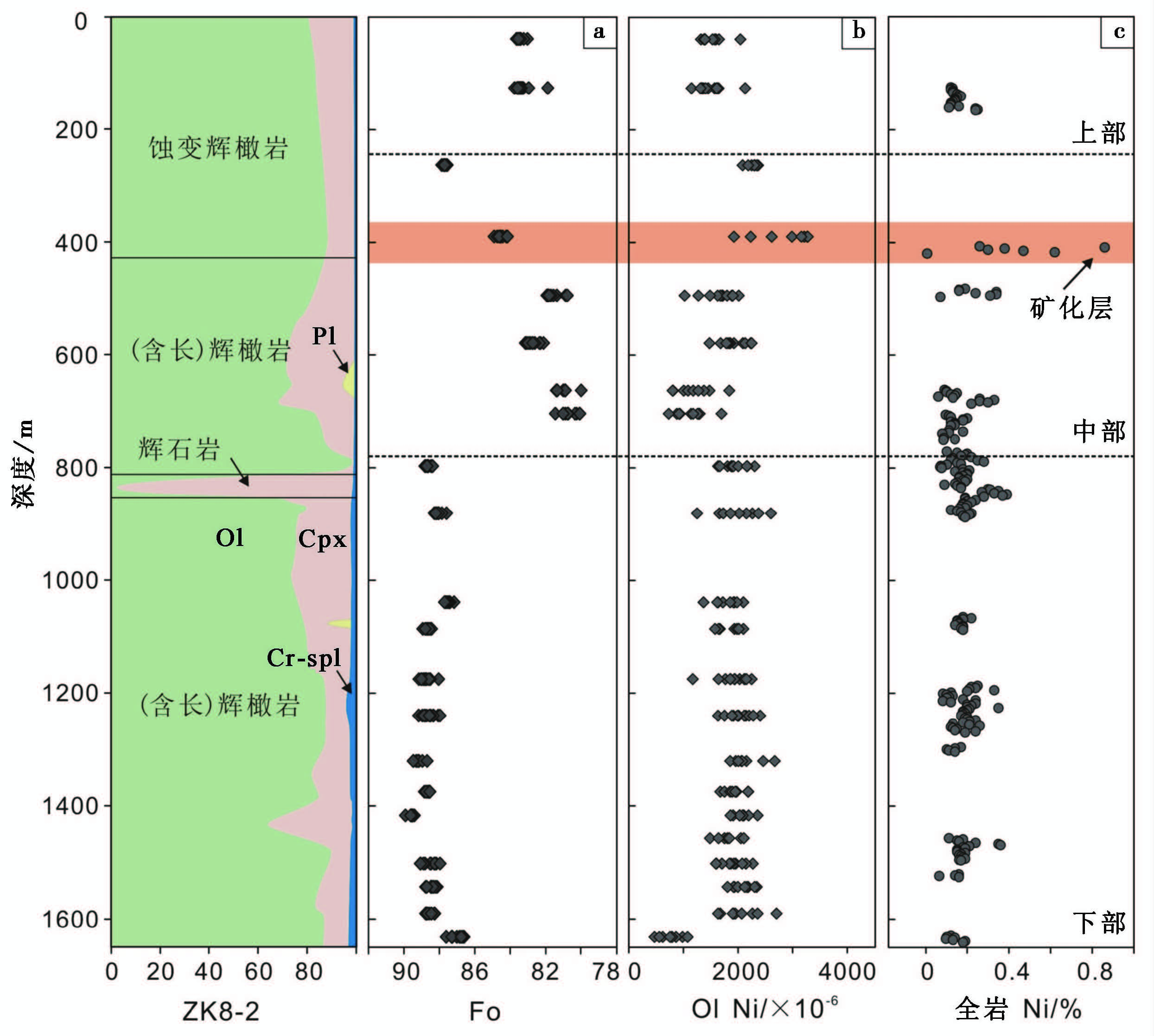
|
图5 坡十钻孔ZK8-2橄榄石成分垂向变化剖面图 a.橄榄石Fo值;b.橄榄石Ni含量/×10-6;c.全岩样品成分中Ni含量/%(据新疆地矿局第六地质大队①) Fig.5 Compositional variations of olivine in borehole ZK8-2 from the Poshi intrusion |
综上所述,在岩浆侵位过程中,坡十母岩浆处于一个动态的岩浆系统中,成分稳定的新鲜岩浆的补给、持续向上的动力及浅部橄榄石快速分离结晶,造成了不同深度橄榄石成分的不同变化。
5.3 母岩浆成分与成岩成矿过程坡北地区并未发现岩体冷凝边或同时代产出的小岩墙来近似代表母岩浆的成分,所以我们应用Li and Riply(2010)建立的利用堆晶相橄榄岩样品计算母岩浆成分的方法。根据Fo值最高的橄榄石成分、以橄榄石为主要堆积矿物的岩石主量成分、橄榄石熔体平衡原理(Roeder and Emslie,1970)和质量平衡原理,进一步计算岩体的母岩浆成分。
坡十超镁铁岩样品中部分含有少量长石,为减小长石堆晶对母岩浆估算结果的影响,尽量选取CaO和Al2O3含量较低的样品;高场强元素Zr在母岩浆分离结晶过程中表现为不相容元素,趋于在残余熔体中富集,所以Zr含量高的样品对应的残余熔体比例相对较高。根据上述前提,我们选取了姜常义等(2006)和颉炜等(2011)中部分辉橄岩主量数据,结合坡十侵入体最原始的橄榄石成分(Fo=89.6)及橄榄石—熔体平衡常数 =0.3(Roeder and Emslie,1970),计算得出坡十母岩浆MgO和FeO的含量分别为14.49%和10.01%(表 3)。坡十母岩浆成分与东天山黄山东岩浆硫化物矿床的原始岩浆估算结果非常接近(MgO=14.56%,FeOt=10.5%)(Mao et al.,2015)。坡十侵入体中被橄榄石包裹的、具有最高Cr#值的铬尖晶石保留了最原始的成分特征,与该颗铬尖晶石平衡的熔体中Al2O3的含量则代表了相对原始的母岩浆的成分,估算过程可以使用如下公式(Maurel and Maurel,1982):(Al2O3)spinel=0.035×(Al2O3)2.42liquid,与坡十最原始的、具有最高Cr#值的铬尖晶石平衡的母岩浆中Al2O3含量为12.43%,这与最原始的橄榄石成分估算出的母岩浆中Al2O3(12.42%)极为接近。坡十母岩浆估算结果中CaO的含量稍高,这与坡十超镁铁岩中填隙相多为含Ca矿物单斜辉石和斜长石有关。
|
|
表 3 坡十母岩浆成分/%估算结果 Table 3 Estimated magma composition/% for the Poshi intrusion |
应用熔浆热力学程序MELTS(Ghiorso and Sack,1995;Asimow and Ghiorso,1998)和估算的坡十母岩浆成分,对橄榄石分离结晶的过程进行模拟,模拟过程使用的条件为:压力1kb、氧逸度FMQ+0.5(铁橄榄石—磁铁矿—石英缓冲对之上的0.5个log单元)。坡十母岩浆中初始的H2O含量设定为0.5%,这个假设基于坡十超镁铁侵入体中含有少量岩浆成因的金云母。使用上述条件进行模拟,模拟结果见 图 6。坡十矿物结晶顺序如下:橄榄石(1 322 ℃)、橄榄石+单斜辉石(1 209 ℃)、橄榄石+单斜辉石+斜长石(1 174 ℃)、斜长石+单斜辉石。上述模拟的分离结晶顺序与坡十侵入体的观察结果基本一致,由于斜方辉石在侵入体中断续出现且计算的母岩浆成分中CaO含量偏高,造成模拟过程中并未出现斜方辉石。单斜辉石温度计(Nimis and Taylor,2000;Putirka,2008)计算结果表明,ZK8-2中辉橄岩的结晶温度约在1 174 ℃~1 223 ℃之间,这与MELTS模拟的单斜辉石结晶的温度区间相近。
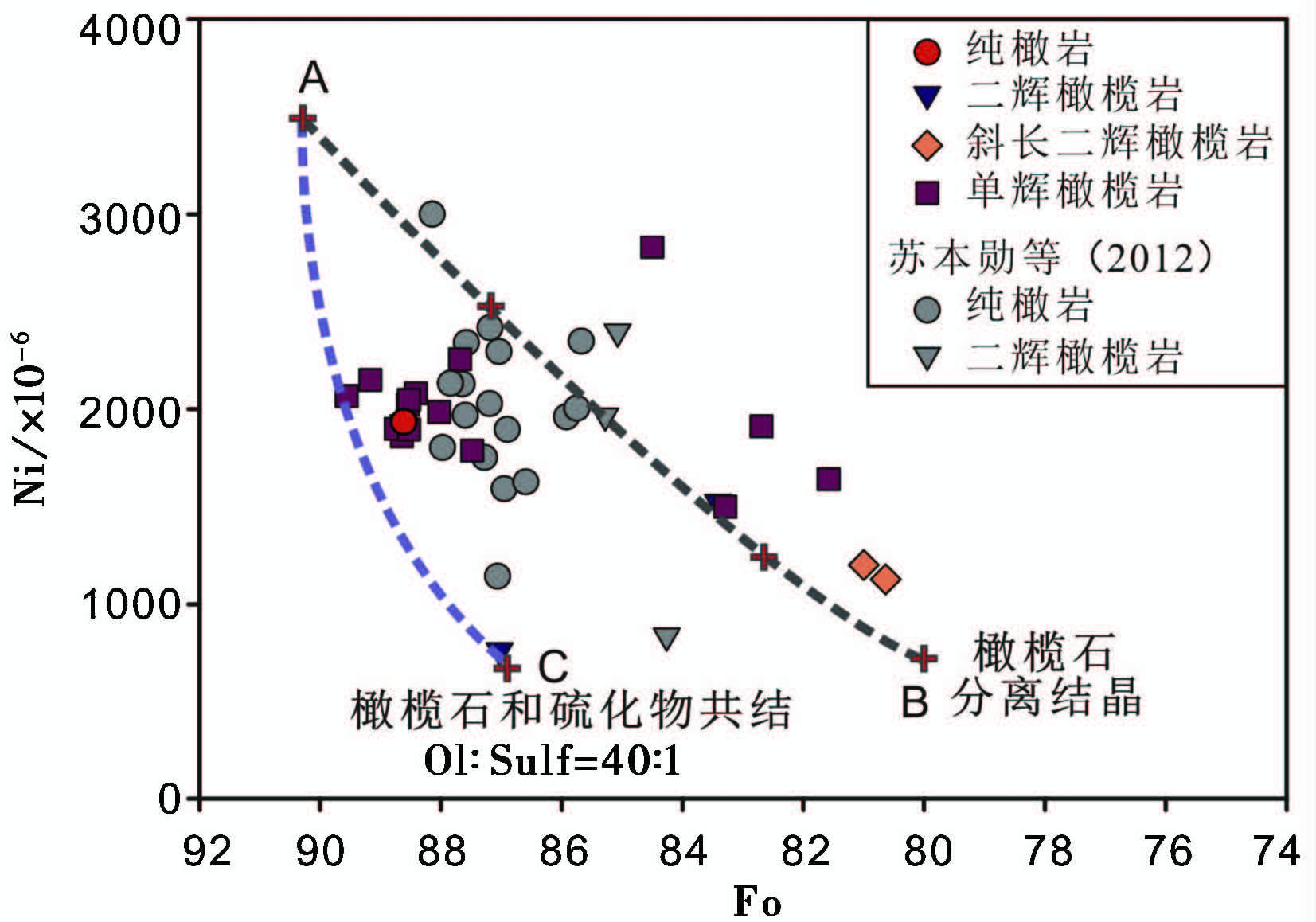
|
图6 坡十侵入体中橄榄石成分模拟结果 AB曲线为熔体中只有橄榄石结晶时,橄榄石的Fo-Ni 演化曲线; AC 曲线为橄榄石和硫化物以40:1共同结晶时橄榄石的演化曲线 Fig.6 Model calculation of Fo and Ni in olivine from the Poshi intrusion |
在橄榄石的分离结晶模拟中,我们使用Li and Ripley(2010)的方法去估算分配系数DOl/LiqNi,坡十超镁铁侵入体中Ni在橄榄石和熔体之间的分配系数为13.68。坡十贫硫化物超镁铁岩中橄榄石大部分落在模拟曲线AB和AC之间(图 6),表明橄榄石中Ni含量的变化主要受橄榄石结晶分异和硫化物不混溶作用共同控制,橄榄石结晶和硫化物熔离同时进行时橄榄石与硫化物的比值为40:1(图 6)。在相对稳定的岩浆系统中,随着早期高Fo值和高Ni含量橄榄石的结晶分离,岩浆中的MgO下降,随后结晶出来的橄榄石Fo值和Ni含量下降,但当橄榄石和硫化物熔体进行反应,Fe-Ni交换反应会使结晶的橄榄石Fo值和Ni含量升高。 图 6中部分橄榄石数据点位于AB曲线上方,表明橄榄石与硫化物熔体发生过较明显的Fe-Ni交换反应。在Voisey’s Bay、金川、黄山东、喀拉通克等岩浆铜镍硫化物矿床中,橄榄石和硫化物的Fe-Ni交换反应普遍存在(Li and Naldrett,1999,Li et al.,2004;李士彬等,2008;邓宇峰等,2011;Gao et al.,2012;毛亚晶等,2014)。
FeO是控制硫在岩浆中溶解度的重要的因素,随着岩浆中FeO含量的下降,硫的溶解度也逐渐降低,硫化物饱和时硫的溶解度与FeO含量表现出强相关性(Haughton et al.,1974)。因此分异的岩浆随着温度的下降,橄榄石和辉石的结晶会带走大量的Fe2+,岩浆中硫的溶解度迅速下降。在坡十侵入体ZK8-2中上段,橄榄石表现出明显的分离结晶作用,并且Ni矿化富集在该岩性段(图 5c),同时 图 6中模拟结果显示橄榄石结晶与硫化物熔离作用同时进行,上述事实说明橄榄石的分离结晶造成残余熔体中Fe2+ 含量的下降,是坡十硫化物熔离的重要因素。坡十超镁铁侵入体中垂向上断续出现斜长石矿物,斜长石结晶会增加残余熔体中FeO的相对含量,进而提高硫化物的溶解度,这样会部分抵消橄榄石结晶对硫化物溶解度的影响(Czamanske and Moore,1977;Naldrett and Von Gruenewaldt,1988)。因此,斜长石的结晶不利于硫化物的熔离,这也是坡十硫化物多呈细粒的浸染状悬浮于侵入体之中,而并未出现稠密状或块状矿石的原因。
5.4 地球动力学模型大部分幔源岩浆与地幔柱、陆内裂谷或后碰撞伸展环境紧密相关(Song et al.,2011)。前人对于东天山—北山地区的镁铁—超镁铁岩体产出提出了多种地球动力学模型,包括二叠纪地幔柱背景(Zhou et al.,2004;Mao et al.,2008;Pirajno et al.,2008),与俯冲相关的Alaskan 型岩体(Xiao et al.,2004,2010;毛启贵等,2006;Han et al.,2010),后碰撞演化的产物(王京彬等,2006,2008;邓宇峰等,2011;Zhang et al.,2011)。最新研究提出东天山—北山地区早二叠世镁铁—超镁铁岩体为早二叠世地幔柱与造山带的叠置的产物(Qin et al.,2011;Tang et al.,2013),但是近期的研究表明上述研究模型仍存在较多争议(Qin et al.,2011;Su et al.,2011)。针对坡北地区而言,姜常义等(2012)认为在塔里木板块东北部的二叠纪岩浆岩与塔里木地幔柱有关,是塔里木大火成岩省的组成部分;Ao et al.(2010)通过岩石学和矿物化学对比,认为北山坡北镁铁—超镁铁岩体是在增生弧环境下形成的Alaskan型岩体。颉炜等(2011)提出坡十岩浆源区为受俯冲事件改造过的交代地幔,而与塔里木地幔柱无关。Song et al.(2011)研究得出后碰撞伸展背景下的板片断离或加厚岩石圈地幔的拆沉造成软流圈上涌,引起减压熔融形成坡北母岩浆,并与上覆俯冲交代的岩石圈地幔发生反应。
坡十侵入体规模较小(<2.5 km2),橄榄岩中补堆晶、中堆晶和正堆晶结构均常见,且包橄结构较为发育(图 2b、图 2e);岩石组合中缺失角闪石岩和辉石岩,以超镁铁岩中发育较多斜长石并形成橄长岩为特征,橄长岩和各种岩性中大量长石的出现表明其母岩浆具有“干”(无或少水)的特征(Niu,2005);坡十出现的角闪石并非原生,而多是后期蚀变过程中由单斜辉石转变而来的。虽然坡十侵入体发育高Fo橄榄石,单斜辉石多为透辉石,金云母亦常见,其岩石学和矿物学上的多种特征与Alaskan型岩体具有实质性差异(Irvine,1974;Helmy and El Mahallawi,2003;Pettigrew and Hattori,2006;Thakurta et al.,2008;Ripley and Li,2009)。坡十超镁铁岩中铬尖晶石成分均未落在Alaskan型超基性杂岩体或大陆溢流玄武岩有关的岩浆岩成分范围内(图 7a、图 7b),而是与黄山东超镁铁岩中尖晶石成分相近,表现出岛弧玄武岩成分特征。坡十侵入体及坡北岩体母岩浆中微量元素均表现出大离子亲石元素(Rb、Sr、Ba)富集、高场强元素(Nb、Ta、Zr、Hf、HREEs)亏损,并显示强烈的Nb、Ta 负异常,也表现出岛弧火山岩的特征(Song et al.,2011;颉炜等(2011),薛胜超等,2015),与东准噶尔北缘的喀拉通克岩体和东天山觉罗塔格构造带的黄山岩体的微量元素特征类似(Song and Li,2009;Mao et al.,2014),两者源区均被认为是交代地幔,因此上述认识说明坡十岩浆源区与受俯冲事件改造的交代地幔关系密切。
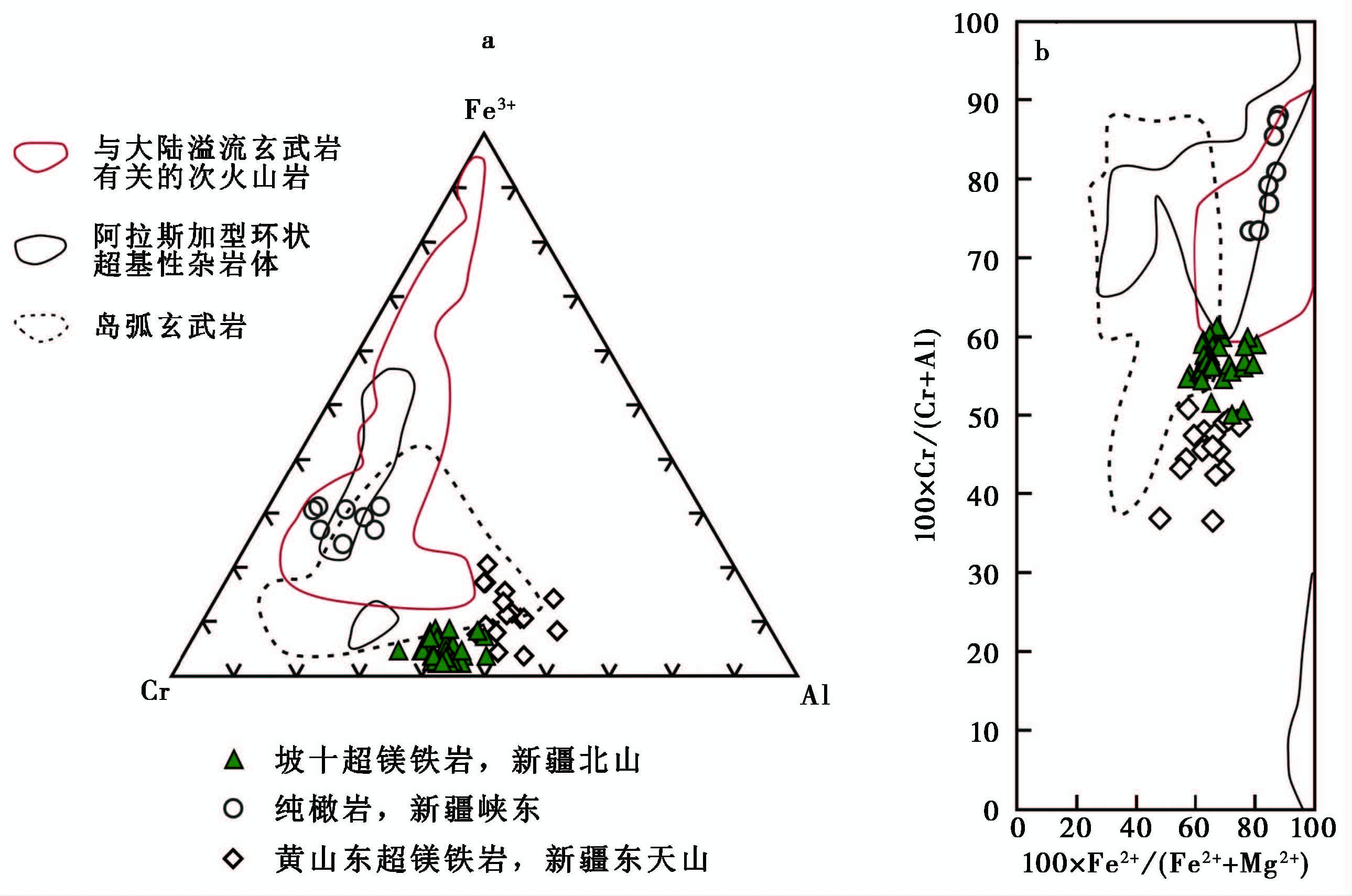
|
图7 坡十超镁铁侵入体中铬尖晶石与不同类型岩体成分对比图解 数据来源:坡十超镁铁岩(本次研究),黄山东超镁铁岩(Mao et al.,2015),峡东Alaskan型岩体(孙赫等,2009a)和其它类型的岩石(Barnes and Roeder,2001) Fig.7 Compositional comparison of Cr-spinel crystals from the Poshi ultramafic rocks and elsewhere in the world |
一般来说,橄榄石的Fo值主要取决于原始岩浆的成分,高Fo的橄榄石最可能来源于地幔源区高程度部分熔融产生的高镁岩浆(Gust and Perfit,1987;Hirose,1997),在地幔中产生高Mg#玄武质岩浆一般需要较高的地幔潜能温度(>1 250 ℃)(Nisbet et al.,1993;Herzberg and O'Hara,2002;Isley and Abbott,2002;Zhou et al.,2004)。这些计算或模拟的温度范围与地幔柱成因的镁铁—超镁铁岩体的形成温度(>1 300 ℃)基本一致(Nisbet et al.,1993;Herzberg and O'Hara,2002;Isley and Abbott,2002),冷的岩石圈地幔并不能出现如此高镁的岩浆作用。实验岩石学研究表明,在单斜辉石—橄榄石—斜长石三元系统的相图上,较低压力条件下橄榄石和斜长石结晶早于单斜辉石,单斜辉石和斜长石出现的交叉压力范围在0.5~0.8 GPa(Morse,1994)。当压力低于0.5 GPa(5 kb)时,无水原生拉斑玄武质岩浆结晶过程中,橄榄石和斜长石形成高温矿物组合,从而出现纯橄岩与橄长岩,而后辉石才开始结晶(Green and Ringwood,1967;Bender et al.,1978;Elthon and Scarfe,1984;Gust and Perfit,1987;Eggins,1992;Kinzler and Grove,1992;Villiger et al.,2004,2007)。坡十侵入体中橄榄石Fo高达90左右,与地幔橄榄石Fo值相近(Simkin and Smith,1970;Hervig and Smith,1982;O'Reilly et al.,1997;Schmidberger and Francis,1999;Jones et al.,2000);坡十超镁铁侵入体中橄榄石比例大部分超过70%,并且垂向上断续有斜长石产出,体现出该地区岩浆演化过程中低压高温的特征。
新疆东部大部分镁铁—超镁铁矿化岩体在相近的年龄范围内(290~270 Ma)(Qin et al.,2011),这些岩体的年龄与塔里木二叠纪大火成岩省晚期岩浆活动的时代重合(杨树锋等,1996;Zhang et al.,2008;陈咪咪等,2010;位荀等,2011)。关于塔里木二叠纪大面积玄武岩喷发事件深部动力学控制因素,被认为是来自深部地幔柱或地幔柱与岩石圈共同作用的结果(厉子龙等,2008;Wei et al.,2014)。然而与塔里木岩浆活动具有紧密时空关系的坡十侵入体在物质成分上并没有明显地表现出地幔柱物质来源的属性(Song et al.,2013),因此,我们认为塔里木地幔柱主要起到为坡十侵入体源区熔融提供热源的作用。由于地幔柱上升过程中携带了巨大能量对俯冲交代的岩石圈地幔进行烘烤、加热,促使地幔地温梯度升高,最终发生坡十侵入体源区地幔熔融事件。本文现有证据并不能排除该区经由大规模岩石圈拆沉作用引起软流圈的上涌,造成上覆交代地幔发生部分熔融的可能。更为精确可靠的年代学证据和北山地区基性岩墙群的研究是下一步工作的方向。
6 结 论本文通过对北山坡十超镁铁侵入体中橄榄石和铬尖晶石矿物化学成分进行系统分析,得到以下主要认识:
(1) 坡十侵入体母岩浆中MgO的含量为14.49%,岩浆侵位过程中,坡十高镁玄武质母岩浆处于一个动态的岩浆系统中,成分稳定的新鲜岩浆的补给、持续的向上的动力及浅部橄榄石快速分离结晶,造成了不同深度橄榄石成分的不同变化;
(2) 橄榄石的分离结晶,是坡十硫化物熔离的重要因素,并且橄榄石与硫化物熔体发生过较明显的Fe-Ni交换反应;
(3) 坡十铬尖晶石成分主要受分离结晶控制,同时经历与次生磁铁矿和早期橄榄石的平衡反应;
(4) 坡十侵入体是俯冲交代的岩石圈地幔部分熔融所形成的母岩浆,在低压高温环境下演化的产物。坡十源区部分熔融的触发机制可能与塔里木地幔柱持续提供的热源或该区拆沉作用引发的软流圈上涌有关。
致谢 野外工作得到新疆地矿局第六地质大队邓刚总工程师、王恒工程师等的支持与帮助;电子探针分析测试得到毛骞老师和马玉光老师的支持;两位匿名审稿专家悉心审稿并提出了宝贵意见和建议,在此一并表示感谢!
| [1] |
陈列锰, 宋谢炎, DanyushevskyL V, 等. 2009. 金川I 号岩体橄榄石Ni-MgO 相互关系及其地质意义. 岩石学报, 25(12) : 3369–3378.
( 0) 0)
|
| [2] |
Chen Liemeng, Song Xieyan, Danyushevsky L V, et al. 2009. Correlation between Ni and MgO contents of olivine in segment I of the Jinchuan intrusion,NW China,and its geological implication. Acta Petrologica Sinica, 25(12) : 3369–3378.
( 0) 0)
|
| [3] |
陈咪咪, 田伟, 张自力, 等. 2010. 塔里木二叠纪基性-中性-酸性岩浆岩的年代学及其地质意义. 岩石学报, 26(2) : 559–572.
( 0) 0)
|
| [4] |
Chen Mimi, Tian Wei, Zhang Zili, et al. 2010. Geochronology of the Permian basic-intermediate-acidic magma suite from Tarim,Northwest China and its geological implications. Acta Petrologica Sinica, 26(2) : 559–572.
( 0) 0)
|
| [5] |
邓宇峰, 宋谢炎, 陈列锰, 等. 2011. 东天山黄山西含铜镍矿镁铁-超镁铁岩体岩浆地幔源区特征研究. 岩石学报, 27(12) : 3640–3652.
( 0) 0)
|
| [6] |
Deng Yufeng, Song Xieyan, Chen Liemeng, et al. 2011. Features of the mantle source of the Huangshanxi Ni-Cu sulfide-bearing mafic-ultramafic intrusion,eastern Tianshan. Acta Petrologica Sinica, 27(12) : 3640–3652.
( 0) 0)
|
| [7] |
邓宇峰, 宋谢炎, 周涛发, 等. 2012. 新疆东天山黄山东岩体橄榄石成因意义探讨. 岩石学报, 28(7) : 2224–2234.
( 0) 0)
|
| [8] |
Deng Yufeng, Song Xieyan, Zhou Taofa, et al. 2012. Correlations between Fo number and Ni content of olivine of the Huangshandong intrusion,eastern Tianshan,Xinjiang,and the genetic significances. Acta Petrologica Sinica, 28(7) : 2224–2234.
( 0) 0)
|
| [9] |
韩宝福, 季建清, 宋彪, 等. 2004. 新疆喀拉通克和黄山东含铜镍矿镁铁-超镁铁杂岩体的 SHRIMP 锆石 U-Pb 年龄及其地质意义. 科学通报, 49(22) : 2324–2328.
( 0) 0)
|
| [10] |
Han Baofu, Ji Jianqing, Song Biao, et al. 2004. SHRIMP zircon U-Pb ages of Kalatongke No. 1 and Huangshandong Cu-Ni-bearing mafic-ultramafic complexes,North Xinjiang,and geological implications.Chinese Science Bulletin, 49(22) : 2424–2429.
( 0) 0)
|
| [11] |
姜常义, 程松林, 叶书锋, 等. 2006. 新疆北山地区中坡山北镁铁质岩体岩石地球化学与岩石成因. 岩石学报, 22(1) : 115–126.
( 0) 0)
|
| [12] |
Jiang Changyi, Cheng Songlin, Ye Shufeng, et al. 2006. Lithogeochemistry and petrogenesis of Zhongposhanbei maric rock body,at Beishan region,Xinjiang. Acta Petrologica Sinica, 22(1) : 115–126.
( 0) 0)
|
| [13] |
姜常义, 郭娜欣, 夏明哲, 等. 2012. 塔里木板块东北部坡一镁铁质-超镁铁质层状侵入体岩石成因. 岩石学报, 28(7) : 2209–2223.
( 0) 0)
|
| [14] |
Jiang Changyi, Guo Naxin, Xia Mingzhe, et al. 2012. Petrogenesis of the Poyi mafic-ultramafic layered intrusion,NE Tarim plate. Acta Petrologica Sinica, 28(7) : 2209–2223.
( 0) 0)
|
| [15] |
李华芹, 梅玉萍, 屈文俊, 等. 2009. 新疆坡北基性-超基性岩带10号岩体 SHRIMP U-Pb 和矿石 Re-Os 同位素定年及其意义. 矿床地质, 28(5) : 633–642.
( 0) 0)
|
| [16] |
Li Huaqin, Mei Yuping, Qu Wenjun, et al. 2009. Shrimp zircon U-Pb and Re-Os dating of No. 10 intrusive body and associated ores in Pobei mafic-ultramafic belt of Xinjiang and its significance.Mineral Deposits, 28(5) : 633–642.
( 0) 0)
|
| [17] |
李士彬, 胡瑞忠, 宋谢炎, 等. 2008. 硫化物熔离对岩浆硫化物含矿岩体中橄榄石Ni 含量的影响--以金川岩体为例. 矿物岩石地球化学通报, 27(2) : 146–152.
( 0) 0)
|
| [18] |
Li Shibin, Hu Ruizhong, Song Xieyan, et al. 2008. Sulfide separation control in Ni content of olivine in bearing-ore intrusion of magma deposit: An example from Jinchuan intrusion. Bulletin of Mineralogy,Petrology and Geochemistry, 27(2) : 146–152.
( 0) 0)
|
| [19] |
厉子龙, 杨树锋, 陈汉林, 等. 2008. 塔西南玄武岩年代学和地球化学特征及其对二叠纪地幔柱岩浆演化的制约. 岩石学报, 24(5) : 959–970.
( 0) 0)
|
| [20] |
Li Zilong, Yang Shufeng, Chen Hanlin, et al. 2008. Chronology and geochemistry of Taxinan basalts from the Tarim Basin: Evidence for Permian plume magmatism. Acta Petrologica Sinica, 24(5) : 959–970.
( 0) 0)
|
| [21] |
毛启贵, 肖文交, 韩春明, 等. 2006. 新疆东天山白石泉铜镍矿床基性-超基性岩体锆石U-Pb同位素年龄、 地球化学特征及其对古亚洲洋闭合时限的制约. 岩石学报, 22(1) : 153–162.
( 0) 0)
|
| [22] |
Mao Qigui, Xiao Wenjiao, Han Chunming, et al. 2006. Zircon U-Pb age and the geochemistry of the Baishiquan mafic-ultramafic complex in the eastern Tianshan,Xinjiang Province: Constraints on the closure of the Paleo-Asian Ocean. Acta Petrologica Sinica, 22(1) : 153–162.
( 0) 0)
|
| [23] |
毛亚晶, 秦克章, 唐冬梅, 等. 2014. 东天山岩浆铜镍硫化物矿床的多期次岩浆侵位与成矿作用--以黄山铜镍矿床为例. 岩石学报, 30(6) : 1575–1594.
( 0) 0)
|
| [24] |
Mao Yajing, Qin Kezhang, Tang Dongmei, et al. 2014. Multiple stages of magma emplacement and mineralization of eastern Tianshan,Xinjiang: Examplified by the Huangshan Ni-Cu deposit. Acta Petrologica Sinica, 30(6) : 1575–1594.
( 0) 0)
|
| [25] |
秦克章, 唐冬梅, 苏本勋, 等. 2012. 北疆二叠纪镁铁-超镁铁岩铜、 镍矿床的构造背景、 岩体类型、 基本特征、 相对剥蚀程度、 含矿性评价标志及成矿潜力分析. 西北地质, 45(4) : 83–116.
( 0) 0)
|
| [26] |
Qin Kezhang, Tang Dongmei, Su Benxun, et al. 2012. The tectonic setting,style,basic feature,relative erosion degree,ore-bearing evaluation sign,potential analysis of mineralization of Cu-Ni-bearing Permian mafic-ultramafic complexes,northern Xinjiang. Northwestern Geology, 45(4) : 83–116.
( 0) 0)
|
| [27] |
苏本勋, 秦克章, 孙赫, 等. 2009. 新疆北山地区红石山镁铁-超镁铁岩体的岩石矿物学特征: 对同化混染和结晶分异过程的启示. 岩石学报, 25(4) : 873–887.
( 0) 0)
|
| [28] |
Su Benxun, Qin Kezhang, Sun He, et al. 2009. Petrological and mineralogical characteristics of Hongshishan mafic-ultramafic complex in Beishan area,Xinjiang: Implications for assimilation and fractional crystallization. Acta Petrologica Sinica, 25(4) : 873–887.
( 0) 0)
|
| [29] |
苏本勋, 秦克章, 孙赫, 等. 2010. 新疆北山地区旋窝岭镁铁-超镁铁岩体的年代学、 岩石矿物学和地球化学研究. 岩石学报, 26(11) : 3283–3294.
( 0) 0)
|
| [30] |
Su Benxun, Qin Kezhang, Sun He, et al. 2010. Geochronological petrological mineralogical and geochemical studies of the Xuanwoling mafic-ultramafic intrusion in Beishan area,Xinjiang. Acta Petrologica Sinica, 26(11) : 3283–3294.
( 0) 0)
|
| [31] |
苏本勋, 秦克章, 唐冬梅, 等. 2011. 新疆北山地区坡十镁铁-超镁铁岩体的岩石学特征及其对成矿作用的指示. 岩石学报, 27(12) : 3627–3639.
( 0) 0)
|
| [32] |
Su Benxun, Qin Kezhang, Tang Dongmei, et al. 2011. Petrological features and implications for mineralization of the Poshi mafic-ultramafic intrusion in Beishan area,Xinjiang. Acta Petrologica Sinica, 27(12) : 3627–3639.
( 0) 0)
|
| [33] |
孙赫, 秦克章, 苏本勋, 等. 2009a. 中天山地块科马提质超镁铁岩体的发现: 新疆峡东岩体. 岩石学报, 25(4) : 738–748.
( 0) 0)
|
| [34] |
Sun He, Qin Kezhang, Su Benxun, et al. 2009a. Discovery of komatiitic ultramafic intrusion in Mid-Tianshan terrain: Xiadong intrusion,Xinjiang. Acta Petrologica Sinica, 25(4) : 738–748.
( 0) 0)
|
| [35] |
孙赫, 唐冬梅, 秦克章, 等. 2009b. 亲铜元素的地球化学行为研究进展及其在岩浆硫化物矿床中的应用. 地质论评, 55(6) : 840–850.
( 0) 0)
|
| [36] |
Sun He, Tang Dongmei, Qin Kezhang, et al. 2009b. Advances of geochemical behavior of chalcophile elements and applications in metallogeny of magmatic Cu-Ni-PGE sulfide deposits. Geological Review, 55(6) : 840–850.
( 0) 0)
|
| [37] |
王京彬, 徐新. 2006. 新疆北部后碰撞构造演化与成矿. 地质学报, 80(1) : 23–31.
( 0) 0)
|
| [38] |
Wang Jingbin and Xu Xin. 2006. Post-collisional tectonic evolution and metallogenesis in northern Xinjiang,China. Acta Geologica Sinica, 80(1) : 23–31.
( 0) 0)
|
| [39] |
王京彬, 王玉往, 周涛发. 2008. 新疆北部后碰撞与幔源岩浆有关的成矿谱系. 岩石学报, 24(4) : 743–752.
( 0) 0)
|
| [40] |
Wang Jingbin, Wang Yuwang and Zhou Taofa. 2008. Metallogenic spectrum related to post-collisional mantle-derived magma in North Xinjiang. Acta Petrologica Sinica, 24(4) : 743–752.
( 0) 0)
|
| [41] |
位荀, 徐义刚. 2011. 塔里木巴楚小海子正长岩杂岩体的岩石成因探讨. 岩石学报, 27(10) : 2984–3004.
( 0) 0)
|
| [42] |
Wei Xun and Xu Yigang. 2011. Petrogenesis of Xiaohaizi syenite complex from Bachu area,Tarim. Acta Petrologica Sinica, 27(10) : 2984–3004.
( 0) 0)
|
| [43] |
肖庆华, 秦克章, 唐冬梅, 等. 2010. 新疆哈密香山西铜镍-钛铁矿床系同源岩浆分异演化产物--矿相学、 锆石U-Pb 年代学及岩石地球化学证据. 岩石学报, 26(2) : 503–522.
( 0) 0)
|
| [44] |
Xiao Qinghua, Qin Kezhang, Tang Dongmei, et al. 2010. Xiangshanxi composite Cu-Ni-Ti-Fe deposit belongs to comagmatic evolution product: Evidences from ore microscopy,zircon U-Pb chronology and petrological geochemistry,Hami,Xinjiang,NW China. Acta Petrologica Sinica, 26(2) : 503–522.
( 0) 0)
|
| [45] |
肖渊甫, 王道永, 吴德超, 等. 2000. 新疆北山构造带西段地质演化. 成都: 四川科学技术出版社 : 113 -139.
( 0) 0)
|
| [46] |
Xiao Yuanfu, Wang Daoyong, Wu Dechao, et al. 2000. Geological Evolution of the Western Beishan Tectonic Belt of Xinjiang. Chendu: Sichuan Science and Technology Press : 113-139.
( 0) 0)
|
| [47] |
颉炜, 宋谢炎, 聂晓勇, 等. 2011. 新疆坡十铜镍硫化物含矿岩体岩浆源区特征及构造背景探讨. 地学前缘, 18(3) : 189–200.
( 0) 0)
|
| [48] |
Xie Wei, Song Xieyan, Nie Xiaoyong, et al. 2011. Features of the mantle source and tectonic setting of the Poshi Ni-Cu sulfide-bearing intrusion,Xinjiang,China. Earth Science Frontiers, 18(3) : 189–200.
( 0) 0)
|
| [49] |
薛胜超, 秦克章, 唐冬梅, 等. 2015. 东疆二叠纪镁铁-超镁铁岩体中辉石的成分特征及其对成岩和 Ni-Cu 成矿的指示. 岩石学报, 31(8) : 2175–2192.
( 0) 0)
|
| [50] |
Xue Shengchao, Qin Kezhang, Tang Dongmei, et al. 2015. Compositional characteristics of pyroxenes from Permian mafic-ultramafic complexes in eastern Xinjiang,and their implications for petrogenesis and Ni-Cu mineralization. Acta Petrologica Sinica, 31(8) : 2175–2192.
( 0) 0)
|
| [51] |
杨树锋, 陈汉林, 董传万, 等. 1996. 塔里木盆地二叠纪正长岩的发现及其地球动力学意义. 地球化学, 25(2) : 121–128.
( 0) 0)
|
| [52] |
Yang Shufeng, Chen Hanlin, Dong Chuanwan, et al. 1996. The discovery of Permian syenite inside Tarim Basin and its geodynamic significance. Geochimica, 25(2) : 121–128.
( 0) 0)
|
| [53] |
Ao S J, Xiao W J, Han C M, et al. 2010. Geochronology and geochemistry of Early Permian mafic-ultramafic complexes in the Beishan area,Xinjiang,NW China: Implications for Late Paleozoic tectonic evolution of the southern Altaids. Gondwana Research, 18(2) : 466–478.
( 0) 0)
|
| [54] |
Asimow P D and Ghiorso M S. 1998. Algorithmic modifications extending MELTS to calculate subsolidus phase relations. American Mineralogist, 83 : 1127–1132.
DOI:10.2138/am-1998-9-1022 ( 0) 0)
|
| [55] |
Barnes S J and Kunilov V Y. 2000. Spinels and Mg ilmenites from the Noril’sk 1 and Talnakh intrusions and other mafic rocks of the Siberian flood basalt province. Economic Geology, 95(8) : 1701–1717.
( 0) 0)
|
| [56] |
Barnes S J and Roeder P L. 2001. The range of spinel compositions in terrestrial mafic and ultramafic rocks. Journal of Petrology, 42(12) : 2279–2302.
DOI:10.1093/petrology/42.12.2279 ( 0) 0)
|
| [57] |
Barnes S J and Tang Z L. 1999. Chrome spinels from the Jinchuan Ni-Cu sulfide deposit,Gansu Province,People’s Republic of China. Economic Geology, 94(3) : 343–356.
DOI:10.2113/gsecongeo.94.3.343 ( 0) 0)
|
| [58] |
Bender J F, Hodges F N and Benee A E. 1978. Petrogenesis of basalts from the project FAMOUS area: EExperimental study from 0 to 15 kbars. Earth and Planetary Science Letters, 41(3) : 277–302.
DOI:10.1016/0012-821X(78)90184-X ( 0) 0)
|
| [59] |
Bliss N W and Maclean W H. 1975. The paragenesis of zoned chromite from central Manitoba. Geochimica et Cosmochimica Acta, 39(6) : 973–990.
( 0) 0)
|
| [60] |
Czamanske G K and Moore J G. 1977. Composition and phase chemistry of sulfide globules in basalt from the Mid-Atlantic ridge rift valley near 37°N lat. Geological Society of America Bulletin, 88(4) : 587–599.
DOI:10.1130/0016-7606(1977)88<587:CAPCOS>2.0.CO;2 ( 0) 0)
|
| [61] |
Dick H J B and Bullen T. 1984. Chromian spinel as a petrogenetic indicator in abyssal and alpine-type peridotites and spatially associated lavas. Contributions to Mineralogy and Petrology, 86(1) : 54–76.
DOI:10.1007/BF00373711 ( 0) 0)
|
| [62] |
Eales H V and Reynolds I M. 1986. Cryptic variations within chromitites of the upper critical zone,northwestern Bushveld complex. Economic Geology, 81(5) : 1056–1066.
DOI:10.2113/gsecongeo.81.5.1056 ( 0) 0)
|
| [63] |
Eggins S M. 1992. Petrogenesis of Hawaiian tholeiites: 1,phase equilibria constraints. Contributions to Mineralogy and Petrology, 110(2-3) : 387–397.
DOI:10.1007/BF00310752 ( 0) 0)
|
| [64] |
Elthon D and Scarfe C M. 1984. High-pressure phase equilibria of a high-magnesia basalt and the genesis of primary oceanic basalts. American Mineralogist, 69 : 1–15.
( 0) 0)
|
| [65] |
Gao J F, Zhou M F, Lightfoot P C, et al. 2012. Origin of PGE-poor and Cu-rich magmatic sulfides from the Kalatongke deposit,Xinjiang,Northwest China. Economic Geology, 107(3) : 481–506.
DOI:10.2113/econgeo.107.3.481 ( 0) 0)
|
| [66] |
Ghiorso M S and Sack R O. 1995. Chemical mass transfer in magmatic processes Ⅳ. A revised and internally consistent thermodynamic model for the interpolation and extrapolation of liquid-solid equilibria in magmatic systems at elevated temperatures and pressures.Contributions to Mineralogy and Petrology, 119(2) : 197–212.
( 0) 0)
|
| [67] |
Green D H and Ringwood A E. 1967. The genesis of basaltic magma. Contributions to Mineralogy and Petrology, 15(2) : 103–190.
DOI:10.1007/BF00372052 ( 0) 0)
|
| [68] |
Gust D A and Perfit M R. 1987. Phase relations of a high-Mg basalt from the Aleutian Island Arc: Implications for primary island arc basalts and high-Al basalts. Contributions to Mineralogy and Petrology, 97(1) : 7–18.
DOI:10.1007/BF00375210 ( 0) 0)
|
| [69] |
Han C M, Xiao W J, Zhao G C, et al. 2010. In-situ U-Pb,Hf and Re-Os isotopic analyses of the Xiangshan Ni-Cu-Co deposit in eastern Tianshan(Xinjiang),central Asia orogenic belt: Constraints on the timing and genesis of the mineralization. Lithos, 120(3-4) : 547–562.
DOI:10.1016/j.lithos.2010.09.019 ( 0) 0)
|
| [70] |
Haughton D R, Roeder P L and Skinner B J. 1974. Solubility of sulfur in mafic magmas. Economic Geology, 69(4) : 451–467.
DOI:10.2113/gsecongeo.69.4.451 ( 0) 0)
|
| [71] |
Helmy H M and El Mahallawi M M. 2003. Gabbro Akarem mafic-ultramafic complex,eastern Desert,Egypt: A Late Precambrian analogue of Alaskan-type complexes. Mineralogy and Petrology, 77(1-2) : 85–108.
DOI:10.1007/s00710-001-0185-9 ( 0) 0)
|
| [72] |
Hervig R L and Smith J V. 1982. Temperature-dependent distribution of Cr between olivine and pyroxenes in lherzolite xenoliths. Contributions to Mineralogy and Petrology, 81(3) : 184–189.
DOI:10.1007/BF00371295 ( 0) 0)
|
| [73] |
Herzberg C and O’Hara M J. 2002. Plume-associated ultramafic magmas of Phanerozoic age. Journal of Petrology, 43(10) : 1857–1883.
DOI:10.1093/petrology/43.10.1857 ( 0) 0)
|
| [74] |
Hirose K. 1997. Melting experiments on lherzolite KLB-1 under hydrous conditions and generation of high-magnesian andesitic melts. Geology, 25(1) : 42–44.
DOI:10.1130/0091-7613(1997)025<0042:MEOLKU>2.3.CO;2 ( 0) 0)
|
| [75] |
Irvine T N. 1965. Chromian spinel as a petrogenetic indicator: Part 1. Theory.Canadian Journal of Earth Sciences, 2(6) : 648–672.
DOI:10.1139/e65-046 ( 0) 0)
|
| [76] |
Irvine T N. 1967. Chromian spinel as a petrogenetic indicator: Part 2. Petrologic applications.Canadian Journal of Earth Sciences, 4(1) : 71–103.
DOI:10.1139/e67-004 ( 0) 0)
|
| [77] |
Irvine T N. 1974. Petrology of the Duke Island ultramafic complex southeastern Alaska. Geological Society of America Memoir, 138 : 1–244.
DOI:10.1130/MEM138 ( 0) 0)
|
| [78] |
Isley A E and Abbott D H. 2002. Implications of the temporal distribution of high-Mg magmas for mantle plume volcanism through time. The Journal of Geology, 110(2) : 141–158.
DOI:10.1086/338553 ( 0) 0)
|
| [79] |
Jones A P, Kostoula T, Stoppa F, et al. 2000. Petrography and mineral chemistry of mantle xenoliths in a carbonate-rich melilititic tuff from Mt. Vulture volcano,southern Italy.Mineralogical Magazine, 64(4) : 593–613.
( 0) 0)
|
| [80] |
Kinzler R J and Grove T L. 1992. Primary magmas of mid-ocean ridge basalts 1. Experiments and methods.Journal of Geophysical Research, 97(B5) : 6885–6906.
DOI:10.1029/91JB02840 ( 0) 0)
|
| [81] |
Lesher C , Keays R. 2002. Komatiite-associated Ni-Cu-PGE deposits: Geology,mineralogy,geochemistry and genesis. Canadian Institute of Mining,Metallurgy and Petroleum,Special Volume, 54 : 579–617.
( 0) 0)
|
| [82] |
Li C and , Naldrett A J. 1999. Geology and petrology of the Voisey’s Bay intrusion: Reaction of olivine with sulfide and silicate liquids. Lithos, 47(1-2) : 1–31.
DOI:10.1016/S0024-4937(99)00005-5 ( 0) 0)
|
| [83] |
Li C, Naldrett A J and Ripley E M. 2001. Critical factors for the formation of a nickel-copper deposit in an evolved magma system: Lessons from a comparison of the Pants Lake and Voisey’s Bay sulfide occurrences in Labrador,Canada. Mineralium Deposita, 36(1) : 85–92.
DOI:10.1007/s001260050288 ( 0) 0)
|
| [84] |
Li C, Ripley E M and Naldrett A J. 2003. Compositional variations of olivine and sulfur isotopes in the Noril’sk and Talnakh intrusions,Siberia: Implications for ore-forming processes in dynamic magma conduits. Economic Geology, 98(1) : 69–86.
( 0) 0)
|
| [85] |
Li C, Xu Z H, De Waal S A, et al. 2004. Compositional variations of olivine from the Jinchuan Ni-Cu sulfide deposit,western China: Implications for ore genesis. Mineralium Deposita, 39(2) : 159–172.
DOI:10.1007/s00126-003-0389-5 ( 0) 0)
|
| [86] |
Li C, Nalddrett A J and Ripley E M. 2007. Controls on the Fo and Ni contents of olivine in sulfide-bearing mafic-ultramafic intrusions: Principles,models and examples from Voisey’s Bay. Earth Science Frontiers, 14(5) : 177–185.
DOI:10.1016/S1872-5791(07)60043-8 ( 0) 0)
|
| [87] |
Li C, Ripley E M. 2010. The relative effects of composition and temperature on olivine-liquid Ni partitioning: Statistical deconvolution and implications for petrologic modeling. Chemical Geology, 275(1-2) : 99–104.
DOI:10.1016/j.chemgeo.2010.05.001 ( 0) 0)
|
| [88] |
Li C, Zhang M J, Fu P E, et al. 2012. The Kalatongke magmatic Ni-Cu deposits in the central Asian orogenic belt,NW China: Product of slab window magmatism?. Mineralium Deposita, 47(1) : 51–67.
( 0) 0)
|
| [89] |
Liipo J, Vuollo J, Nyknen V, et al. 1995. Chromites from the Early Proterozoic Outokumpu-Jormua ophiolite belt: A comparison with chromites from Mesozoic ophiolites. Lithos, 36(1) : 15–27.
DOI:10.1016/0024-4937(95)00002-W ( 0) 0)
|
| [90] |
Mao J W, Pirajno F, Zhang Z H, et al. 2008. A review of the Cu-Ni sulphide deposits in the Chinese Tianshan and Altay orogens(Xinjiang Autonomous Region,NW China): Principal characteristics and ore-forming processes. Journal of Asian Earth Sciences, 32(2-4) : 184–203.
DOI:10.1016/j.jseaes.2007.10.006 ( 0) 0)
|
| [91] |
Mao Y J, Qin K Z, Li C, et al. 2014. Petrogenesis and ore genesis of the Permian Huangshanxi sulfide ore-bearing mafic-ultramafic intrusion in the central Asian orogenic belt,western China. Lithos, 200-201 : 111–125.
DOI:10.1016/j.lithos.2014.04.008 ( 0) 0)
|
| [92] |
Mao Y J, Qin K Z, Li C, et al. 2015. A modified genetic model for the Huangshandong magmatic sulfide deposit in the central Asian orogenic belt,Xinjiang,western China. Mineralium Deposita, 50(1) : 65–82.
DOI:10.1007/s00126-014-0524-5 ( 0) 0)
|
| [93] |
Maurel C and Maurel P. 1982. Etude expérimentale de la solubilité du chrome dans les bains silicatés basiques et sa distribution entre liquide et minéraux coexistants: conditions d’existence du spinelle chromifére. Bulletin Minéralogie, 105 : 197–202.
( 0) 0)
|
| [94] |
Morse S A.1994.Basalts and Phase Diagrams: An Introduction to the Quantitative Use of Phase Diagrams in Igneous Petrology.New York: Springer-Verlag.345—360.
( 0) 0)
|
| [95] |
Naldrett A J. 1999. World-class Ni-Cu-PGE deposits: Key factors in their genesis. Mineralium Deposita, 34(3) : 227–240.
DOI:10.1007/s001260050200 ( 0) 0)
|
| [96] |
Naldrett A J and Von Gruenewaldt G.1988.The Association of the PGE with Chromitite in Layered Intrusions and Ophiolite Complexes.Pretoria: University of Pretoria Institute for Geological Research on the Bushveld Complex.180—187.
( 0) 0)
|
| [97] |
Nimis P and Taylor W R. 2000. Single clinopyroxene thermobarometry for garnet peridotites. Part Ⅰ.Calibration and testing of a Cr-in-Cpx barometer and an enstatite-in-Cpx thermometer.Contributions to Mineralogy and Petrology, 139(5) : 541–554.
( 0) 0)
|
| [98] |
Nisbet E G, Cheadle M J, Arndt N T, et al. 1993. Constraining the potential temperature of the Archaean mantle: A review of the evidence from komatiites. Lithos, 30 : 291–307.
DOI:10.1016/0024-4937(93)90042-B ( 0) 0)
|
| [99] |
Niu Y L. 2005. Generation and evolution of basaltic magmas: Some basic concepts and a new view on the origin of Mesozoic-Cenozoic basaltic volcanism in eastern China. Geological Journal of China Universities, 11(1) : 9–46.
( 0) 0)
|
| [100] |
O’Reilly S Y, Chen D, Griffin W L, et al. 1997. Minor elements in olivine from spinel lherzolite xenoliths: Implications for thermobarometry. Mineralogical Magazine, 61(2) : 257–269.
( 0) 0)
|
| [101] |
Pettigrew N T and Hattori K H. 2006. The Quetico Intrusions of Western Superior Province: Neo-Archean examples of Alaskan/Ural-type mafic-ultramafic intrusions. Precambrian Research, 149(1) : 21–42.
( 0) 0)
|
| [102] |
Pirajno F, Mao J W, Zhang Z C, et al. 2008. The association of mafic-ultramafic intrusions and A-type magmatism in the Tian Shan and Altay orogens,NW China: Implications for geodynamic evolution and potential for the discovery of new ore deposits. Journal of Asian Earth Sciences, 32(2-4) : 165–183.
DOI:10.1016/j.jseaes.2007.10.012 ( 0) 0)
|
| [103] |
Putirka K D. 2008. Thermometers and barometers for volcanic systems. Reviews in Mineralogy and Geochemistry, 69(1) : 61–120.
DOI:10.2138/rmg.2008.69.3 ( 0) 0)
|
| [104] |
Qin K Z, Su B X, Sakyi P A, et al. 2011. SIMS zircon U-Pb geochronology and Sr-Nd isotopes of Ni-Cu-bearing mafic-ultramafic intrusions in eastern Tianshan and Beishan in correlation with flood basalts in Tarim Basin(NW China): Constraints on a ca. 280 Ma mantle plume.American Journal of Science, 311(3) : 237–260.
( 0) 0)
|
| [105] |
Ripley E M and Li C.2009.Ni-Cu-PGE mineralization associated with the Proterozoic Midcontinent rift system,USA.In: Li C and Ripley E M(Eds.).New Developments in Magmatic Ni-Cu and PGE Deposits.Beijing: Geological Publishing House.180—191.
( 0) 0)
|
| [106] |
Roeder P L and Campbell I H. 1985. The effect of postcumulus reactions on composition of chrome-spinels from the Jimberlana intrusion. Journal of Petrology, 26(3) : 763–786.
DOI:10.1093/petrology/26.3.763 ( 0) 0)
|
| [107] |
Roeder P L and Emslie R F. 1970. Olivine-liquid equilibrium. Contributions to Mineralogy and Petrology, 29(4) : 275–289.
DOI:10.1007/BF00371276 ( 0) 0)
|
| [108] |
Schmidberger S S , Francis D. 1999. Nature of the mantle roots beneath the North American craton: Mantle xenolith evidence from Somerset Island kimberlites. Lithos, 48(1) : 195–216.
( 0) 0)
|
| [109] |
Simkin T and Smith J V. 1970. Minor-element distribution in olivine. The Journal of Geology, 78(3) : 304–325.
DOI:10.1086/627519 ( 0) 0)
|
| [110] |
Song X Y and Li X R. 2009. Geochemistry of the Kalatongke Ni-Cu-(PGE)sulfide deposit,NW China: Implications for the formation of magmatic sulfide mineralization in a postcollisional environment. Mineralium Deposita, 44(3) : 303–327.
DOI:10.1007/s00126-008-0219-x ( 0) 0)
|
| [111] |
Song X Y, Xie W, Deng Y F, et al. 2011. Slab break-off and the formation of Permian mafic-ultramafic intrusions in southern margin of central Asian orogenic belt,Xinjiang,NW China. Lithos, 127(1-2) : 128–143.
DOI:10.1016/j.lithos.2011.08.011 ( 0) 0)
|
| [112] |
Song X Y, Chen L M, Deng Y F, et al. 2013. Syncollisional tholeiitic magmatism induced by asthenosphere upwelling owing to slab detachment at the southern margin of the central Asian orogenic belt. Journal of the Geological Society, 170(6) : 941–950.
DOI:10.1144/jgs2012-130 ( 0) 0)
|
| [113] |
Su B X, Qin K Z, Sakyi P A, et al. 2011. U-Pb ages and Hf-O isotopes of zircons from Late Paleozoic mafic-ultramafic units in southern central Asian orogenic belt: Tectonic implications and evidence for an Early-Permian mantle plume. Gondwana Research, 20(2) : 516–531.
( 0) 0)
|
| [114] |
Su B X, Qin K Z, Sakyi P A, et al. 2012. Occurrence of an Alaskan-type complex in the Middle Tianshan massif,central Asian orogenic belt: Inferences from petrological and mineralogical studies. International Geology Review, 54(3) : 249–269.
DOI:10.1080/00206814.2010.543009 ( 0) 0)
|
| [115] |
Tang D M, Qin K Z, Li C, et al. 2011. Zircon dating,Hf-Sr-Nd-Os isotopes and PGE geochemistry of the Tianyu sulfide-bearing mafic-ultramafic intrusion in the central Asian orogenic belt,NW China. Lithos, 126(1-2) : 84–98.
DOI:10.1016/j.lithos.2011.06.007 ( 0) 0)
|
| [116] |
Tang D M, Qin K Z, Su B X, et al. 2013. Magma source and tectonics of the Xiangshanzhong mafic-ultramafic intrusion in the central Asian orogenic belt,NW China,traced from geochemical and isotopic signatures. Lithos, 170-171 : 144–163.
DOI:10.1016/j.lithos.2013.02.013 ( 0) 0)
|
| [117] |
Thakurta J, Ripley E M and Li C. 2008. Geochemical constraints on the origin of sulfide mineralization in the Duke Island complex,southeastern Alaska. Geochemistry,Geophysics,Geosystems, 9(7).
DOI:10.1029/2008GC001982 ( 0) 0)
|
| [118] |
Tian W, Campbell I H, Allen C M, et al. 2010. The Tarim picrite-basalt-rhyolite suite,a Permian flood basalt from Northwest China with contrasting rhyolites produced by fractional crystallization and anatexis. Contributions to Mineralogy and Petrology, 160(3) : 407–425.
DOI:10.1007/s00410-009-0485-3 ( 0) 0)
|
| [119] |
Villiger S, Ulmer P, Miintener O, et al. 2004. The liquid line of descent of anhydrous,mantle-derived,tholeiitic liquids by fractional and equilibrium crystallization: An experimental study at 1. 0 GPa.Journal of Petrology, 45(12) : 2369–2388.
DOI:10.1093/petrology/egh042 ( 0) 0)
|
| [120] |
Villiger S, Ulmer P and Miintener O. 2007. Equilibrium and fractional crystallization experiments at 0. 7 GPa; the effect of pressure on phase relations and liquid compositions of tholeiitic magmas.Journal of Petrology, 48(1) : 159–184.
( 0) 0)
|
| [121] |
Wei X, Xu Y G, Feng Y X, et al. 2014. Plume-lithosphere interaction in the generation of the Tarim large igneous province,NW China: Geochronological and geochemical constraints. American Journal of Science, 314(1) : 314–356.
DOI:10.2475/01.2014.09 ( 0) 0)
|
| [122] |
Xia M Z, Jiang C Y, Li C, et al. 2013. Characteristics of a newly discovered Ni-Cu sulfide deposit hosted in the Poyi ultramafic intrusion,Tarim Craton,NW China. Economic Geology, 108(8) : 1865–1878.
DOI:10.2113/econgeo.108.8.1865 ( 0) 0)
|
| [123] |
Xiao W J, Zhang L C, Qin K Z, et al. 2004. Paleozoic accretionary and collisional tectonics of the eastern Tianshan(China): Implications for the continental growth of central Asia. American Journal of Science, 304(4) : 370–395.
DOI:10.2475/ajs.304.4.370 ( 0) 0)
|
| [124] |
Xiao W J, Mao Q G, Windley B F, et al. 2010. Paleozoic multiple accretionary and collisional processes of the Beishan orogenic collage. American Journal of Science, 310(10) : 1553–1594.
DOI:10.2475/10.2010.12 ( 0) 0)
|
| [125] |
Xue S C, Qin K Z, Li C, et al. 2016. Geochronological,petrological,and geochemical constraints on Ni-Cu sulfide mineralization in the Poyi ultramafic-troctolitic intrusion in the northeast rim of the Tarim craton,western China. Economic Geology, 111(6) : 1465–1484.
DOI:10.2113/econgeo.111.6.1465 ( 0) 0)
|
| [126] |
Yang S H, Zhou M F, Lightfoot P C, et al. 2014. Re-Os isotope and platinum-group element geochemistry of the Pobei Ni-Cu sulfide-bearing mafic-ultramafic complex in the northeastern part of the Tarim craton. Mineralium Deposita, 49(3) : 381–397.
DOI:10.1007/s00126-013-0496-x ( 0) 0)
|
| [127] |
Zhang C L, Li X H, Li Z X, et al. 2008. A Permian layered intrusive complex in the western Tarim block,northwestern China: Product of a ca. 275 Ma mantle plume?The Journal of Geology, 116(3) : 269–287.
( 0) 0)
|
| [128] |
Zhang C L, Li Z X, Li X H, et al. 2010a. A Permian large igneous province in Tarim and central Asian orogenic belt,NW China: Results of a ca. 275 Ma mantle plume.Geological Society of America Bulletin, 122(11-12) : 2020–2040.
DOI:10.1130/B30007.1 ( 0) 0)
|
| [129] |
Zhang C L, Xu Y G, Li Z X, et al. 2010b. Diverse Permian magmatism in the Tarim block,NW China: Genetically linked to the Permian Tarim mantle plume. Lithos, 119(3-4) : 537–552.
DOI:10.1016/j.lithos.2010.08.007 ( 0) 0)
|
| [130] |
Zhang Y Y, Dostal J, Zhao Z H, et al. 2011. Geochronology,geochemistry and petrogenesis of mafic and ultramafic rocks from southern Beishan area,NW China: Implications for crust-mantle interaction. Gondwana Research, 20(4) : 816–830.
DOI:10.1016/j.gr.2011.03.008 ( 0) 0)
|
| [131] |
Zhou M F, Keays R R, Lightfoot P C, et al. 1997. Petrogenetic significance of chromian spinels from the Sudbury Ignecus complex,Ontario,Canada. Canadian Journal of Earth Science, 34(10) : 1405–1419.
DOI:10.1139/e17-113 ( 0) 0)
|
| [132] |
Zhou M F, Lesher C M, Yang Z X, et al. 2004. Geochemistry and petrogenesis of 270 Ma Ni-Cu-(PGE)sulfide-bearing mafic intrusions in the Huangshan district,eastern Xinjiang,Northwest China: Implications for the tectonic evolution of the central Asian orogenic belt. Chemical Geology, 209(3-4) : 233–257.
DOI:10.1016/j.chemgeo.2004.05.005 ( 0) 0)
|
| [133] |
Zhou M F, Zhao J H, Jiang C Y, et al. 2009. OIB-like,heterogeneous mantle sources of Permian basaltic magmatism in the western Tarim Basin,NW China: Implications for a possible Permian large igneous province. Lithos, 113(3-4) : 583–594.
DOI:10.1016/j.lithos.2009.06.027 ( 0) 0)
|
 2016, Vol. 51
2016, Vol. 51


